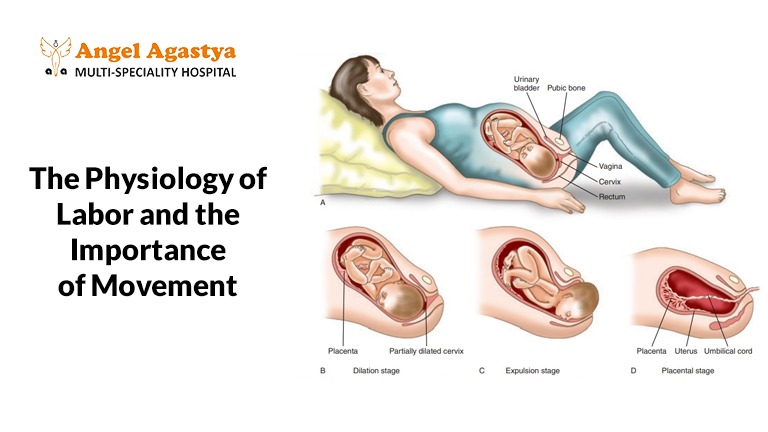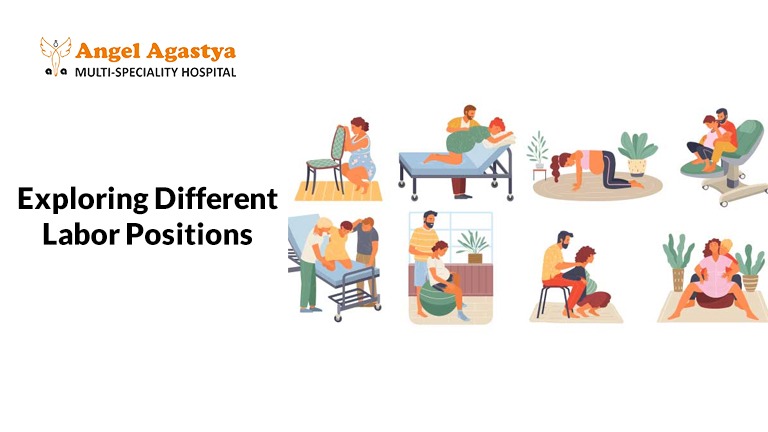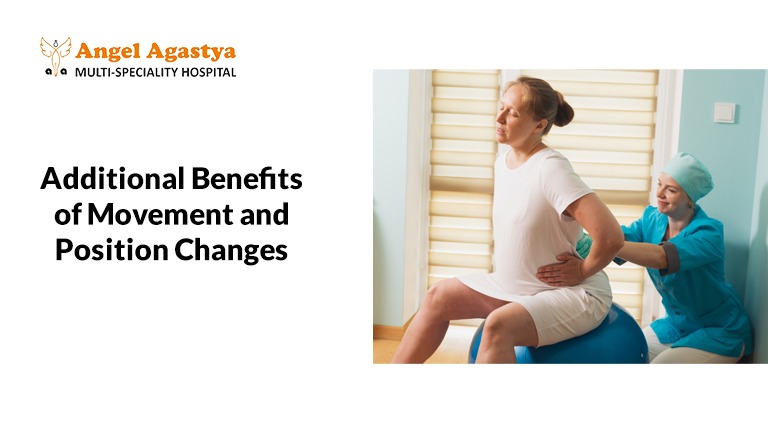Benefits of Movement and Position Changes for a Painless Normal Delivery
Discover how staying active and changing positions during labor can ease pain, speed up delivery, and create a smoother birthing experience. Learn the science-backed reasons why movement and position changes are essential for a natural, painless delivery.
Introduction
Movement and position during labor play a pivotal role in making normal delivery a profoundly transformative and empowering experience, yet it is often framed in ways that emphasize pain and passivity. Traditional labor practices, especially in clinical settings, frequently encourage women to lie still, often on their backs, which can counteract the natural mechanics of labor. However, modern research and experiences highlight the significant role that movement and position changes play in facilitating a smoother, less painful delivery. These strategies empower women to work with their bodies, harnessing the natural forces of gravity, improving circulation, and creating optimal conditions for the baby’s descent.
The Physiology of Labor and the Importance of Movement

Labor is a highly dynamic process requiring the synchronized actions of muscles, hormones, and gravity. Each stage of labor can benefit from different types of movement and position adjustments, ensuring that the body works efficiently to deliver the baby.
The Role of Gravity
Gravity is an essential, natural force that assists in the progression of labor.
- Encouraging Baby’s Descent: Upright positions, such as standing, walking, squatting, or kneeling, make full use of gravity, allowing the baby’s head to move downward toward the cervix. This can help the cervix dilate more quickly and reduce the overall duration of labor.
- Avoiding Counterproductive Positions: Conversely, lying on the back (supine position) or reclining at too steep an angle can hinder gravity’s effect, potentially prolonging labor and increasing the risk of interventions.
- Pressure on the Cervix: The baby’s head pressing downward can stimulate the release of oxytocin, the hormone responsible for strengthening uterine contractions and advancing labor.
Opening the Pelvis
Different movement and position directly impact how the pelvis opens and adapts to the baby’s movement.
- Squatting or Kneeling: These positions can widen the pelvic diameter by up to 30%, providing more space for the baby to move through the birth canal.
- Dynamic Movements: Gentle rocking, swaying, or leaning forward can allow the pelvic joints and ligaments to adjust naturally, ensuring the optimal alignment for the baby’s descent.
Improving Circulation and Oxygenation
Movement and position also plays a vital role in ensuring adequate oxygen supply for both mother and baby.
- Better Blood Flow: Regular position changes reduce the risk of blood pooling in the lower body, improving circulation to the uterus and placenta. This ensures the baby receives sufficient oxygen and nutrients throughout labor.
- Reduced Fatigue: Improved blood flow can reduce muscle fatigue, allowing the mother to maintain her strength and stamina during labor.
Exploring Different Labor Positions
Each laboring woman’s experience is unique, and the effectiveness of various movement and position may vary depending on the stage of labor and individual comfort. Here are some of the most beneficial labor positions:

1. Upright Positions
Being upright allows gravity to assist in labor progression and can provide relief from contractions.
- Walking: Walking helps stimulate contractions, encourages the baby’s descent, and fosters a sense of control and empowerment.
- Squatting: Squatting widens the pelvic outlet and provides optimal space for the baby’s movement. It is particularly effective during the pushing stage of labor.
- Kneeling: Kneeling can relieve back pain and utilize gravity to help the baby move downward.
- Leaning: Leaning against a partner, a birthing ball, or a sturdy surface can help open the pelvis and alleviate discomfort.
2. Water Birth Positions
Water immersion during labor provides unique benefits, including freedom of movement and relaxation.
- Buoyancy for Support: The buoyancy of water reduces the weight and strain on the mother’s body, making it easier to change positions.
- Floating or Squatting: Mothers can experiment with positions like floating on their backs, squatting in the water, or leaning on the edge of the tub.
- Soothing Pain Relief: Warm water relaxes muscles, eases back pain, and promotes a calming environment.
3. Side-Lying (Lateral) Positions
Lying on the side can be an effective and restful position, especially during early labor or when the mother needs to conserve energy.
- Relieving Back Pain: Side-lying reduces pressure on the back and pelvis.
- Promoting Circulation: This position enhances blood flow to the uterus and placenta.
4. Hands-and-Knees Position
This position is particularly useful for relieving back labor, where the baby’s head presses against the mother’s lower spine.
- Alleviating Back Pain: The hands-and-knees position helps shift the baby into a more favorable position for birth.
- Opening the Pelvis: It allows the pelvic bones to move more freely, creating space for the baby.
The Importance of Freedom of Movement and Support
Women need an environment that encourages and facilitates movement and position during labor. Creating such an environment involves providing the right tools, emotional support, and freedom to move without restrictions.

1. Creating a Supportive Environment
Midwives, doulas, and healthcare providers play a crucial role in supporting movement during labor.
- Encouragement and Guidance: Trained professionals can suggest beneficial positions and techniques tailored to each stage of labor.
- Birthing Tools: Birthing balls, stools, and adjustable beds can help mothers experiment with different positions.
- Comfortable Space: Labor rooms designed with ample space and calming decor can make movement feel natural and uninhibited.
2. Challenging Traditional Practices
Traditional models of childbirth often restrict movement and position, particularly in clinical settings where continuous monitoring and the use of epidurals are common.
- Reevaluating Hospital Practices: Hospitals should aim to adopt more flexible protocols that prioritize maternal comfort and autonomy.
- Breaking Myths: Educating both healthcare providers and expectant mothers about the safety and benefits of movement can help dispel myths about the “risks” of leaving the bed.
3. Empowering Women to Make Informed Choices
Education is key to ensuring women feel confident in their ability to labor naturally and effectively.
- Childbirth Education Classes: Prenatal classes can teach women about the benefits of movement and position changes during labor.
- Personalized Birth Plans: Encouraging women to create birth plans that include preferences for movement and positions can help them feel more in control.
The Role of Birth Partners and Doulas
Support persons, including partners, family members, and doulas, play a vital role in promoting movement and position during labor. Their encouragement and hands-on support empower the mother to move freely, adapt comfortable positions, and better manage labor pains.

- Providing Physical Support: Birth partners can help the mother maintain positions, apply counter-pressure, or massage her back during contractions.
- Offering Emotional Reassurance: Continuous emotional support can reduce stress and promote relaxation, which is crucial for pain management.
- Advocating for Mobility: Doulas can advocate for the mother’s right to move freely, even in settings where restrictions may be in place.
Additional Benefits of Movement and Position Changes
Beyond facilitating a smoother labor process, movement and position changes offer several other benefits:

- Reducing the Need for Interventions: Movement can reduce the likelihood of medical interventions, such as epidurals, forceps, or cesarean sections.
- Enhancing Hormonal Efficiency: Upright positions and movement can stimulate the release of endorphins and oxytocin, hormones that promote pain relief and labor progress.
- Promoting a Positive Birth Experience: Women who feel in control of their labor are more likely to view their birth experience as positive and empowering.
Overcoming Barriers to Movement During Labor
Despite the proven benefits, many women face barriers that restrict movement during labor. These may include:

- Medical Interventions: Continuous electronic fetal monitoring or IV lines can limit mobility.
- Hospital Policies: Some hospitals may encourage or require women to stay in bed during labor.
- Lack of Knowledge: Women who are unaware of the benefits of movement may feel hesitant to explore different positions.
Solutions:
- Advocacy and Education: Healthcare providers should educate women about their options and advocate for policies that support freedom of movement.
- Alternative Monitoring Techniques: Intermittent monitoring and wireless devices can allow for greater mobility.
Conclusion
Movement and position changes during labor are not merely optional extras but essential tools for facilitating a more comfortable and empowering birth experience. By embracing movement, utilizing gravity, and exploring various positions, women can actively participate in the natural process of childbirth.
With the right support and education, expectant mothers can harness the power of movement to reduce pain, promote efficient labor, and create a positive and fulfilling birth experience. For both mothers and their babies, the freedom to move is a simple yet transformative practice that deserves greater attention in modern childbirth practices.
FAQs
1. What are the benefits of upright positions during labor?
Upright positions like standing, walking, squatting, or sitting can help use gravity to move the baby down toward the birth canal. These positions also open up the pelvis, making more room for the baby to pass through. Many women find these positions more comfortable, and they can help make contractions more effective, possibly shortening labor.
2. How can I incorporate movement into my labor plan?
You can include movement by planning to change positions often during labor. Walk around the room, use a birthing ball to sway or bounce gently, or lean on furniture for support. These movements can help you stay comfortable, keep labor progressing, and make contractions more manageable.
3. What are some creative ways to use gravity to my advantage during labor?
Gravity can help move the baby down when you are in an upright or forward-leaning position. Try squatting, kneeling, or using a birthing stool. Even sitting on a birthing ball or leaning forward onto a bed can use gravity to assist your baby’s movement.
4. What are the benefits of water birth in terms of movement and positioning?
Water reduces the feeling of weight, making it easier to move around and change positions. It helps you relax, reduces pain, and makes it easier to squat or kneel in the water, which are great positions for labor. The warmth of the water can also soothe your body and make contractions feel less intense.
5. How can my partner or doula support me in moving freely during labor?
Your partner or doula can encourage you to change positions, support you physically while you squat or lean, and remind you to stay mobile. They can also provide massages, use counter-pressure techniques, or hold your hands while you walk or sway. Their encouragement and hands-on help can keep you comfortable and confident.
6. What are some common barriers to movement during labor?
Some barriers include being connected to medical equipment like IV lines or fetal monitors, being confined to the bed, or feeling too tired. Hospital policies or lack of support from your care team can also make it harder to stay active during labor.
7. How can I advocate for freedom of movement in the hospital setting?
Talk to your doctor or midwife during pregnancy about your desire to move freely during labor. Include it in your birth plan and discuss it with the hospital staff when you arrive. You can ask for wireless monitors or intermittent monitoring if needed, so you aren’t restricted to the bed.
8. What are the risks associated with limited movement during labor?
Staying in one position, especially lying flat on your back, can slow down labor, increase discomfort, and make contractions feel stronger and less effective. Limited movement can also reduce blood flow to the baby, potentially increasing the chance of interventions like a C-section.
9. How can I prepare my body for labor through movement and exercise during pregnancy?
Gentle exercises like walking, prenatal yoga, swimming, and squats can strengthen your muscles, improve flexibility, and prepare your body for labor. Practicing these movements during pregnancy can make it easier to stay active and use effective positions during labor.
10. How can I find a healthcare provider who supports freedom of movement during labor?
Look for a provider who values natural birthing techniques and encourages active labor. Ask questions during prenatal visits, such as whether they allow intermittent monitoring, encourage upright positions, or support birthing aids like balls or stools. Choosing a supportive provider ensures you’ll have the freedom to move as needed during labor.

